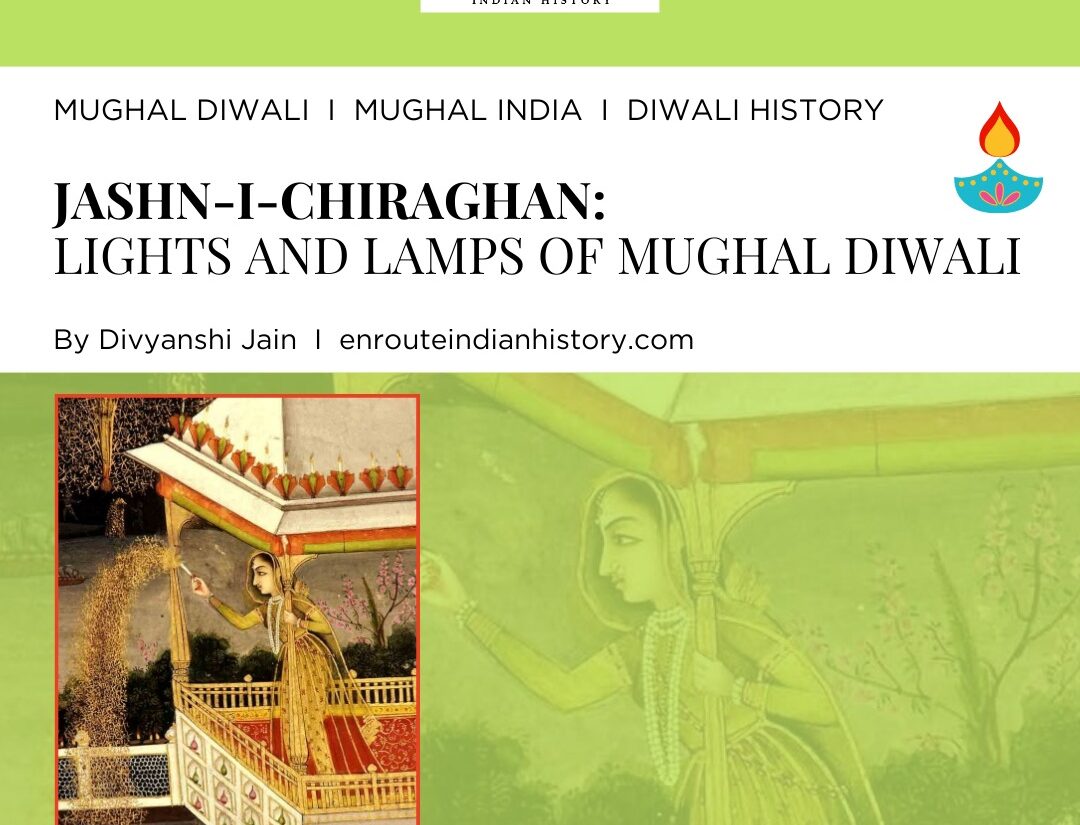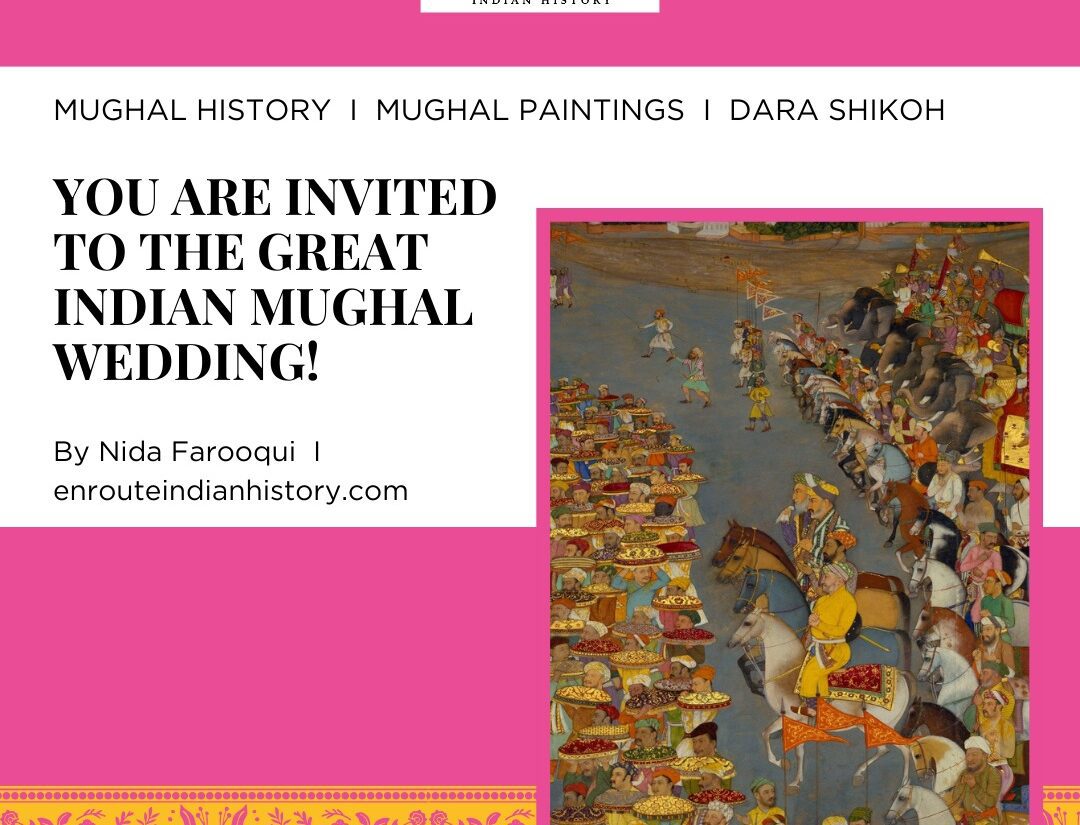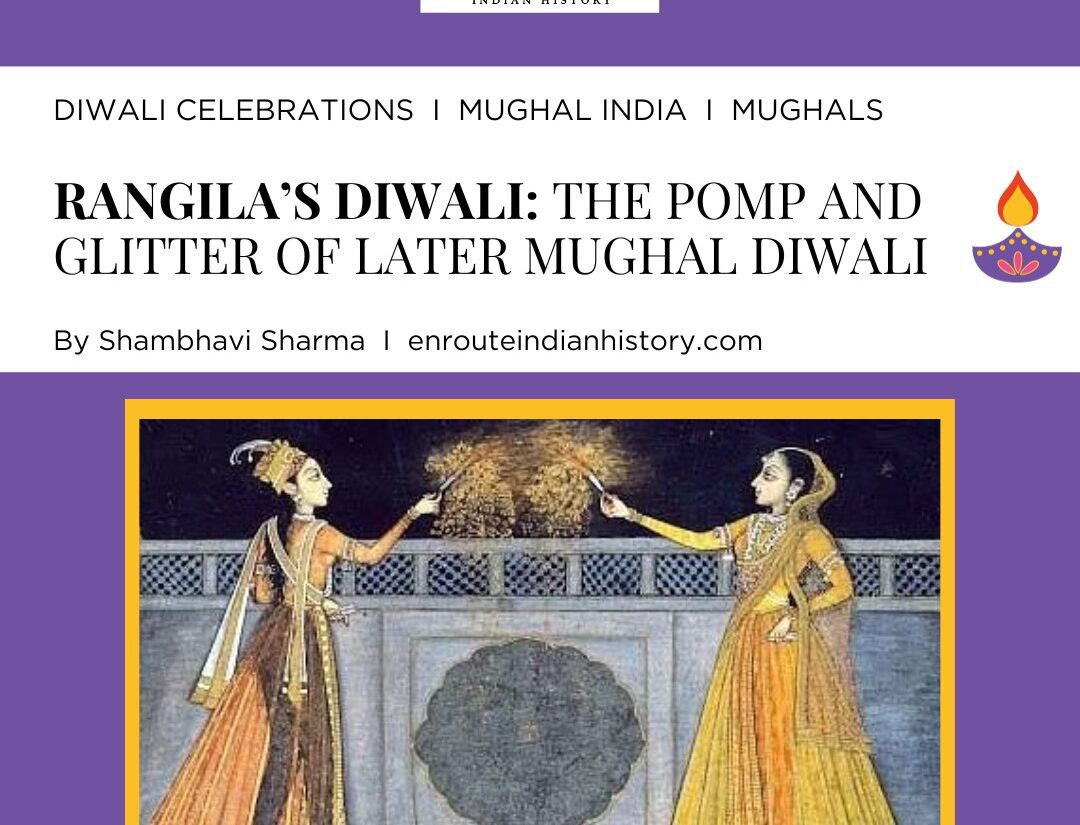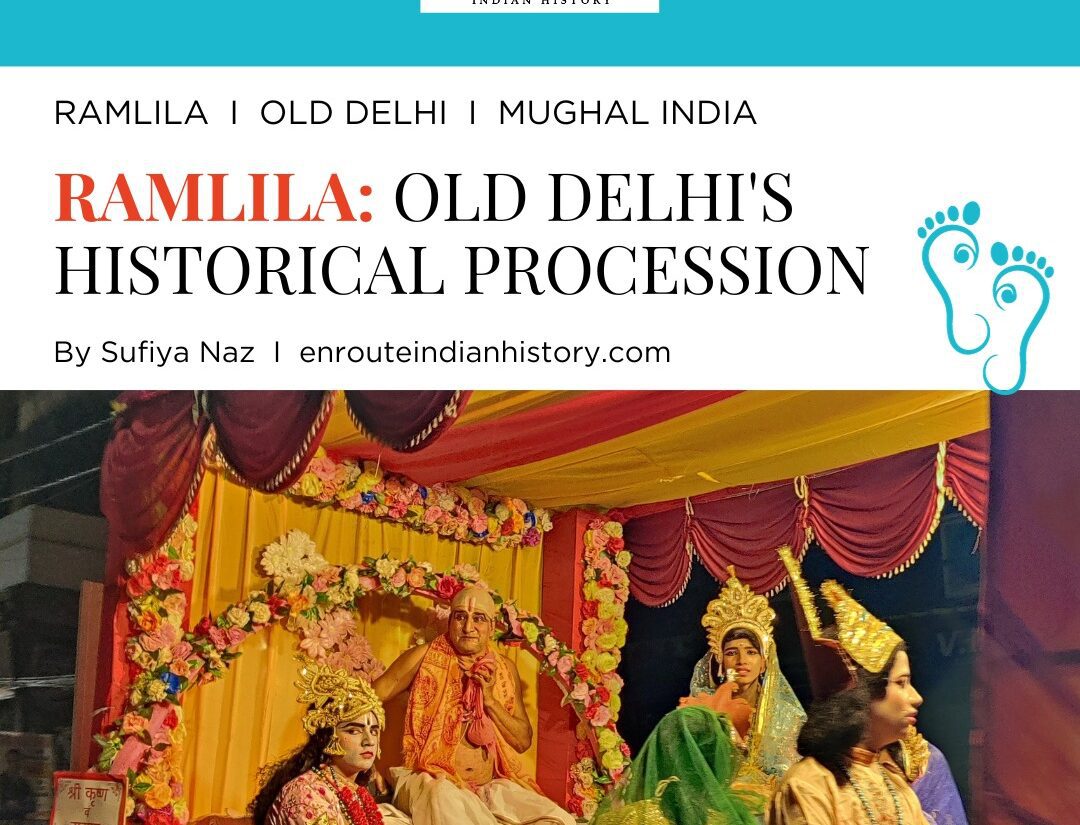
history of Mughal Diwali
The history of Mughal Diwali brilliantly displays Akash diya and fireworks that lit up the medieval skies. But there’s more to it than just the lights – it has a story, a beginning, a special meaning, and a lasting tradition. Imagine a celebration called “Jashn-i-chiraghan,” meaning “celebration of lamps.” Mughal Diwali wasn’t just a one-day event. It started with Dussehra and continued for days before and after the main Diwali day, like an extended festival. The Mughals loved art and culture, and they embraced the Ramayana, an ancient epic, in their celebrations. They translated it into Persian and painted beautiful pictures to bring the story to life during Mughal Diwali.
The Mughal Diwali

Celebrating with fireworks, opaque watercolour and gold on paper; late Mughal, Muhammad Shah period; or oudh; second quarter of the 18th century. Photo courtesy: San Diego Museum of Art.

Prince and princess holding fireworks in Provincial Mughal India, circa 1750-60. Photo courtesy: Christie’s.
Amid the vibrant fireworks captured in Mughal paintings, there’s a magical element known as the “Akash diya” or sky lamp. During the Jashn-e-Chiraghan, these lamps were perched high on poles, illuminating the night sky. In the enchanting world of Hindu mythology, gods are believed to reside in three realms: the sky, the atmosphere, and the earth. The Akash diya embodies the belief that stars themselves are like lamps, lit to honour the deities of these celestial domains.
Mughal Diwali celebrations, when viewed in today’s context, were as vibrant as modern times. The Mughals had a deep connection with the symbolism of light, a tradition that resonated with their culture. Fazl, Akbar’s court historian, often spoke of divine light in his writings, and this concept became central to the Mughal theory of kingship. Gradually, the sun took a significant place in Akbar’s concept of “Tauhid-i-Ilahi.”
One might wonder if this concept of divine light had any connection to Mughal Diwali. It’s plausible that the story of Rama’s triumphant return after victory played a role in motivating Akbar and other Mughal emperors to partake in Diwali celebrations.

One of a series of eight paintings bound in an album. The series is from a ‘baramasa’ set or ‘songs of the seasons’. Radha and Krishna stand on a white terraced pavilion in a house lit with oil lamps indicating the celebration of the festival of Diwali. The black sky studded with stars, and a nearby town lit with lamps (on which they gaze) indicate a night scene. Radha and Krishna are shown again in the same architectural setting in a room playing a board game that looks like chess. Radha is seen making a move while lady musicians entertain the couple. Gambling at Diwali is a ritual to propitiate Lakshmi, the goddess of wealth. Photo courtesy: British
Just as we can see the importance of gambling and money in the painting above, literary texts also corroborate the same. The accounts in “Jahangirnama” also mention Diwali celebrations at the Mughal court. Jahangir described Diwali as a festival of the Vaishya caste, involving the worship of Lakshmi.
Fireworks in other Mughal festivities
Shab-i-Bara’at

Shab-i-Barat Celebrations. Zebannissa, Aurangzeb’s daughter, celebrates the Shab-i-Barat festival with fireworks. Mughal miniature from the mid-18th century, Photo courtesy: Pergamon Museum, Berlin

“Fireworks on the Night of Shab-i Barat Feast”, Folio from the Davis Album. 18th century. Photo courtesy: Metropolitan Museum of Art.
Fireworks are important during Shab-i-Barat as they bring happiness and create a festive atmosphere. While not directly religious, they symbolize celebration and joy, making the night special. They also foster community bonding, where people gather to celebrate together, strengthening their relationships. This tradition has cultural significance and has been passed down through generations, adding to the festive spirit of Shab-i-Barat.
Dara Shikoh’s Marriage procession

The marriage procession of Dara Shikoh, 1740s. Photo courtesy: National Museum, Delhi.
In the above painting, the bride’s side is seen receiving the marriage procession with a magnificent firework display. Interestingly, even Shahjahan’s son, Dara Shikoh, favored continuing the tradition of Diwali. He used to ride on an elephant through the city on Diwali night to enjoy the lights. However, this tradition seemed to fade after Dara’s tragic death and Shahjahan’s imprisonment by Aurangzeb, who held orthodox religious beliefs. During Aurangzeb’s reign and the rule of his successors, troubled by Maratha attacks on the Mughal empire, there are no records of Diwali celebrations at the Agra Fort.
Fireworks in unspecified paintings

A princess and attendants on a terrace enjoying fireworks, India, Mughal, 18th century, Photo courtesy: Sotheby’s
This scene of a princess and her companions enjoying fireworks on a terrace at night may represent the festival of Diwali, the annual Hindu festival of light, or the Muslim festival of Shab-Bara’at, on which fireworks and illuminations are lit, people seek forgiveness and their future fortunes are determined.

Zenana scene with fireworks. Mughal dynasty, 17th century. Photo courtesy: Freer Gallery of Art.

Court Ladies Playing with Fireworks. Attributed to Muhammad Afzal (active 1740-1780), Mughal court. Photo courtesy: Freer Gallery of Art.

Collections, Virtual museum of images and sounds
The paintings have a common thread tied to them- one of celebration through lights and firecrackers and other is women. We find princesses of zenana accompanied by maids bursting crackers.While in other painting shows a princess alone. Moroever, the dark sky brightened by akash diyas and fireworks reminds of how Diwali night is observed on a no-moon day.
A glimpse on Diwali of Oudh and Deccan

Ladies Playing with Fireworks, school of Mir Kalan Khan, Lucknow, circa 1780; Photo courtesy: Sotheby’s.

Two women sit beneath a pavilion and watch the fireworks held by three maids, Court: Hyderabad, School: Deccani. Photo courtesy:The San Diego Museum of Art
While Mughals used fireworks for celebration in Diwali and other festivities, the kingdoms of Oudh and Hyderabad were not behind. Paintings such as the one in which ladies are playing with fireworks represent the joy and happiness of individuals who found the sparkles as fun as contemporary times.
Fireworks in Mughal times were not limited to Jashn-i-chiraghan as can be seen through the paintings. While some paintings are specifically for Diwali celebrations, other identify as that of Shab-i-Bara’at night or a marriage procession while others still remain open to our interpretations. Whatever, the interpretation be, we have seen how paintings of Mughal times have lights and lamps glistening through them, calling us to dig deeper into them to know more about the medieval times.
References
- “The Visualisation of Ramayana in the Mughal Paintings under Akbar’s Patronage.” Sahapedia, www.sahapedia.org/visualisation-ramayana-mughal-paintings-under-akbars-patronage. Accessed 4 Nov. 2023.
- “Discovering Jashn-e-Chiraghan, the Mughal Festival of Lights.” The Wire, thewire.in/history/how-the-mughals-celebrated-diwali. Accessed 3 Nov. 2023.
- Sharma, Ruchika. “Jashn –E – Chiragha Thewire.In.” Academia.Edu, 20 Oct. 2017, www.academia.edu/34907729/Jashn_e_Chiragha_thewire_in.
- Service, Tribune News. “Emperor’s Jashn-e-Chiraghan.” Tribuneindia News Service, www.tribuneindia.com/news/archive/features/emperors-jashn-e-chiraghan-677282. Accessed 4 Nov. 2023.
- December 4, 2023
- 9 Min Read
- November 20, 2023
- 10 Min Read
- November 6, 2023
- 9 Min Read





















